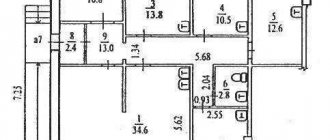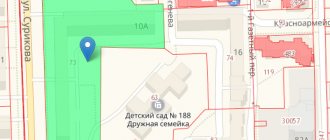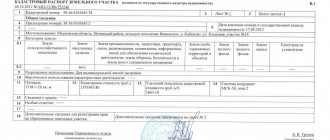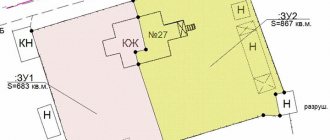Features of the shared ownership regime
Shared ownership implies ownership and disposal of a certain part in the common property with certain restrictions. If a citizen wants to sell, donate or bequeath his share, it is necessary to take into account the interests of other owners ().
In addition to the fact that the owners dispose of the property with the consent of the other participants, they also bear expenses in proportion to their shares.
Knowing what common shared property is, it is easier to understand the rules of joint ownership. Specific parts belonging to co-owners are not allocated in such a situation. For example, by default it is considered that an apartment purchased by spouses is divided in half between husband and wife. The same can be said about owning a house or a joint farm ().
We invite you to find out in more detail what is the difference between shared ownership and joint ownership.
Shared ownership of residential premises and territory
Common ownership of a house and land occurs very often in practice. The owners exercise their rights in accordance with the intended purpose of the property and to the extent permitted by law. However, if one of the owners of the building contributed to making the house better, equipped it with new equipment, completed the premises, made repairs, he has the right to claim an increase in his part in real estate.
Since a private house is located on a plot of land, this territory is also in the shared ownership of citizens. You cannot sell an exclusively residential property. A transaction should also be drawn up for a land plot under a private house in shared ownership. These components are inseparable from each other.
Learn more about what features common shared ownership of a land plot has.
What does the owner of a minor share have the right to?
“A participant in shared ownership also has the right to demand the allocation of his share in kind, if the nature of the property allows this. For example, this is possible in a residential building (with separate exits in different parts of the house, independent utilities, etc.). The possibility and expediency of the separation is assessed by the court in each specific case,” notes Daria Pogorelskaya, head of the legal department of the MIC Group of Companies. In reality, it is impossible to allocate a share in an apartment, since this requires a separate entrance, bathroom and kitchen.
• inability to allocate a share in kind;
• the impossibility of determining the procedure for using the apartment in accordance with the share without violating the rights of the owner of a significant share;
• lack of an actually established procedure for use (the owner of a small share has never moved in or lived in the apartment since the acquisition of the right, and has not made any claims about it);
• share owners are strangers;
• whether such owner of another home has any right, etc.
Determination of shares in common property
Determining contributions to property is important when dividing real estate. The basic rules governing this process are contained in:
- the parts belonging to co-owners are determined by their consent or in accordance with the law;
- the method of determining shares is fixed in the agreement between the participants;
- the size of the shares may vary;
- if a private house in shared ownership was improved with the money of one of the co-owners, he has the right to demand an increase in his share in the property.
Find out how shares in the right of common shared ownership are determined.
How many maximum owners can a property have?
My wife and I divorced a year ago.
When we were married, I bought an apartment. The purchase and sale agreement was drawn up in my name. The ex-wife refused the apartment. At the moment she has entered into a new marriage. How can I discharge her from the quart. more details I am a participant in shared construction. The plan for the construction of a residential building included a waste disposal facility, but it was not built. The house has already been put into operation. Is it possible in such a situation to require the installation of a garbage chute, in accordance with the design document? more details
Procedure for operating an object owned by several persons
There are two ways to determine the operation of real estate:
- Reaching agreement between all participants. Citizens discuss and establish mutual rights and obligations for residential premises and land, and other property that belongs to common property.
- A court determination of how joint ownership of the house will take place. To do this, the participant submits a statement of claim, which sets out the essence of the requirements.
When considering the issue, the court pays attention to the following factors:
- size of share and number of owners;
- presence/absence of family ties between participants;
- registration of relatives;
- layout of the facility, technical feasibility of allocating isolated rooms;
- number of inputs, outputs;
- established order of using the house.
Find out more about what the procedure for using residential premises in shared ownership includes.
Registration of premises in common shared ownership
Registration of a house as shared ownership is a complex legal process. The procedure can be divided into several stages:
- Determining the size of the property. To do this, you should use the services of appraisers. You will have to pay for this, but the owners of the premises will know the exact area of the plot and the square footage of the building. Information is displayed in the sales contract, certificate of inheritance, or court decision.
- Obtaining a technical passport and floor plan from the BTI.
- Registration of a house with a plot in the cadastre authorities and Rosreestr. As a result, an extract from the Unified State Register will be issued. The document allows you to register ownership. If the building is located on the territory of summer cottages, it is not necessary to enter it into the cadastre.
- Paying the state fee and receiving a receipt. The amount of the fee is fixed in the Tax Code of the Russian Federation.
Each home owner will receive a document confirming the ownership of a share in the property.
Often, property owners are interested in how to register a built house as shared ownership individually, and whether this is even possible. A similar option is provided for in the legislation, but such a citizen must provide written consent of all interested parties
Preparation of documents
Any legal actions with real estate are accompanied by the collection of a package of documents. Its composition depends on the specific situation. As a general rule, in order to register a house as a property, if the land is in shared ownership, you need to submit to the Rosreestr body:
- Citizen's identity card.
- The original and a copy of the power of attorney, certified by a notary, if a representative is acting on behalf of the owner.
- Cadastral passport for housing.
- Permission to put the building into operation.
- Documents of title to property: purchase and sale agreement, will, and so on.
- An application drawn up in the prescribed form and signed by the citizen.
- Receipt for payment of state duty.
The application along with a package of documents can also be submitted through the Multifunctional Center.
Registration of land plot under the house
To legally use residential premises, you must become the owner or permanent user of the territory on which it is located. In accordance with this, it is possible to privatize the land under the house. In addition, the owners can buy the plot or arrange a lease for it ().
In this case, title documents must be drawn up for the land. Without them, operation of the site entails administrative liability ().
It is extremely rare that owners have to decide what to do if the land is not shared ownership. Such a right is exclusive unless otherwise provided by law. In other words, the house always goes together with the land as an inextricable whole.
Share in a house with a separate entrance
An unauthorized building is subject to demolition or bringing it into compliance with the parameters established by the rules of land use and development, territory planning documentation, or mandatory requirements for the parameters of the building provided for by law (hereinafter referred to as the established requirements), by the person who carried it out or at his expense, and in the absence of information about him by a person in ownership, lifelong inheritable possession, permanent (perpetual) use of which is the land plot on which an unauthorized building is erected or created, or by a person to whom such a land plot, which is in state or municipal ownership, has been granted for temporary possession and use , or at the expense of the relevant person, except for the cases provided for in paragraph 3 of this article, and cases where the demolition of an unauthorized building or its bringing into compliance with established requirements is carried out in accordance with the law by a local government body.
45.1. Lyudmila, Good afternoon! From the content of your question it follows that part of the house passes by inheritance. Thus, there is no need for its privatization (free acquisition of state or municipal residential premises into ownership). This person's ownership of a part of the house arose from the moment the inheritance was opened (the death of the testator). Regarding the registration of rights to land, it is necessary to understand the following: Currently, the Legislator does not allow the formation of plots occupied by parts of a building. To make the right decision, you need to order an extract from the Unified State Register of Real Estate in relation to the land plot you are interested in: - if the extract contains information about the plot that was formed earlier and occupied by part of the house, then you can purchase it as a property; - if the extract contains information that the plot is occupied by both an apartment building and a house, part of which is being purchased, then, in the absence of the consent of all owners of the premises, the plot can only be purchased for rent.
We recommend reading: Who to write a complaint about the management company
How to transfer a building from shared ownership to personal ownership
If homeowners are not relatives, disagreements often begin between them. As a result, one of the co-owners may decide to separate their part.
Transfer from public to private ownership is not prohibited by law. There are several ways to turn shared ownership into private property. This applies not only to the allocation in kind of a part belonging to one person. All shareholders may want to allocate them, which will lead to the alienation of the house.
How ownership is transferred
The fastest way to transfer ownership is through donation. All co-owners must sign the deed of gift. The document is certified by a notary. With a deed of gift and a set of other documents, you should go to Rosreestr to register rights and obtain an extract from the Unified State Register of Real Estate.
If the property is transferred to a non-relative, the transaction is subject to personal income tax; in other cases, no government fees are charged.
It is also possible to transfer shared ownership into individual ownership through the court. The claim must indicate what area the person is claiming. The court will determine in its decision:
- Footage allocated to each owner.
- Object partition algorithm, if possible.
- Mode of use of common areas.
With a court decision, you can contact the registration authority or the MFC to register ownership of the share.
If other owners do not object to legal changes, the agreement for the division of a private residential building will be drawn up quickly. After this, you need to visit the department of architecture and urban planning. In addition to the title documents for housing, you will need a project on the basis of which you can determine the shares allocated in kind.
After checking the provided papers, an employee of the architectural department will issue a permit, which will allow the construction of a permanent wall in the house and a separate entrance.
In order for the registration of a house on a site in shared ownership to go smoothly, you need to complete two more steps:
- Demarcate a common plot of land.
- Receive a technical and cadastral plan for each share from the BTI.
Having completed a cadastral extract, the owners turn to the Federal Cadastre Service for documents confirming their right to shares in the house. Based on this document, a citizen has the right to sell, donate, or lease his part of the property.
Fee for registration of transfer of rights
The state fee for the service of registering the transfer of ownership is provided for in the Tax Code of the Russian Federation. The fee must be paid when contacting the Rosreestr or MFC authority.
According to, the amount of the fee depends on the specific situation, but on average the cost of transferring a house from shared ownership is about 2,000 rubles.
The director of the legal service “Unified Center for Protection” (edin.center) Konstantin Bobrov answers:
In this case, the property is escheated, since the sole heir, by his behavior, expresses his refusal to inherit the share. This means that part of the house will become the property of the municipality (rural settlement) within which the house is located, in accordance with Article 1151 of the Civil Code of the Russian Federation. However, based on Article 250 of the said law, the shared owner has the preemptive right to purchase a share in the right of common ownership. That is, if the municipality is faced with the question of who to sell the share to - the owner of another share or a third party, then it must make a decision in favor of the first. In case of violation of the preemptive right, the administration may be required to comply with it in court (by filing an appropriate application).
In order to purchase part of a house, you need to contact the administration of the rural settlement, since the procedure for the alienation of municipal property is established there. In this case, it will be possible to purchase a share only for a fee, the amount of which is also determined by local government. The basis for the transfer of ownership of part of the house will be an agreement concluded with the administration.
Features of selling a house
When selling residential premises, the consent of the co-owners is key. If the participants do not object to the transaction, the house and land are alienated as a single whole.
It should be clearly defined whether everything is sold together or not. If the house is sold as a single object, the amount of personal income tax is considered common and is calculated in equal parts between all participants in the process. If the premises are sold in separate shares, the tax is calculated for each of them.
When lawyers are asked the easiest way to sell a house in shared ownership, they recommend drawing up a single purchase and sale agreement. It must indicate:
- price of the object;
- who will receive what amount after the transaction;
- the procedure for settlement with each owner;
- deadlines for vacating the premises and other important circumstances.
You can draw up a draft agreement yourself, but the document must be checked and certified by a notary.
We must not forget that the sale of a house in shared ownership is inextricably linked with the alienation of the land on which the object is located. This increases the cost of the transaction.
From a separate article you can learn how to sell an apartment in shared ownership.
Sale of a share of residential premises
If one of the owners wants to sell his share in the property, he must remember the priority right of other owners to purchase a share (Article 250 of the Civil Code of the Russian Federation). Before selling part of the house to a third party, they should be the first to inform about their intention and announce the terms of the transaction. An exception is the sale of housing at public auction or the sale of a share located on a land plot, part of which the person also owns.
Ways to notify owners:
- registered letter by mail with a list of attachments;
- notification from the notary with the following information: object and sale price,
- terms and conditions of payment,
- term of transfer of property and so on.
Within a month, the co-owners must respond to the proposal. If they do not intend to buy the share being sold, the initiator of the transaction may look for other buyers.
Confirmation that the sale of his share was carried out legally and the seller did not neglect the obligation to notify the co-owners may be a copy of the telegram received at the post office or a certificate of sending/transfer of notice.
Private house or apartment
Maintenance of the apartment by the owners is much easier. The management company, that is, the housing office, takes full responsibility. All you have to do is pay utilities. However, do not forget that they are constantly becoming more expensive. There are often cases of fraud when the housing office simply overcharges you for services that you did not receive, or charges you extra watts for electricity or cubic meters for water supply. There are a lot of pitfalls. It also doesn’t matter whether you used the apartment or not, you are still obliged to pay for utilities. The average bill for utilities for a one-room apartment is 4-5 thousand rubles. It may vary depending on the season and area of residence, number of rooms. For example, in winter the costs of maintaining an apartment, that is, utilities, are more expensive, but in summer they are cheaper. Nevertheless, this item of expenditure for many citizens takes up almost a third of their income, if not more, which is very sad. The most important thing is that no one cares how much you earn or what the size of your pension is. You are obligated to pay the entire apartment maintenance bill. This is the difficult burden of maintaining an apartment.
We recommend reading: Statement of claim to determine the amount of alimony debt
The maintenance of a private house also has its own nuances. In this case, all responsibility for maintaining your country house lies purely with the owner, that is, no matter what happens, you bear all expenses. For example, imagine a situation where there was a hurricane and the roof of the house was blown off. You will solve the problem yourself. All repair work on roof maintenance, replacement of utilities, etc. you do so at your own expense. However, there is no need to be sad. At the same time, for housing and communal services (HCS), you pay strictly for the amount of water, electricity, etc. that you actually used, that is, you do not need to overpay for anything. Compared to an apartment in the summer, utilities for a house are 120 sq. m. can amount to 1200 rubles for electricity and gas. In winter, as in an apartment, the cost will be approximately 3000-4000 rubles. This is a very important and pleasant plus of your built home.
House division options
The home owner has the right to divide the common property. Division and allocation of a share in kind are different concepts. In the first option, the property is divided among all co-owners, in the second, a specific participant receives his part.
Citizens are often interested in how to divide a house that is in common shared ownership. The fastest way to do this is if you can reach an agreement with the other owners. To do this, an agreement is drawn up with a notary, and then the division takes place according to the algorithm mentioned above: obtaining permission from the architectural department, registration with the cadastral register.
If agreement is not reached, the issue is resolved through the court. When dividing the premises, the conclusion of the construction and technical examination is taken into account, because not in every case it is technically possible to reconstruct the house.
When the shares are unequal, monetary compensation may be awarded to the owner who owns the smallest part.
With a court decision, each owner applies to Rosreestr for title documents for the property. It should always be remembered that in addition to the premises there is land. The territory can also be divided only if there is a technical possibility for this.
Often, a residential building is divided into two apartments during a divorce. In fact, two new ones appear from one room. In this case, it should be possible to divide the land on which the building is located. If this is not possible, the court will most likely refuse to satisfy the claim and establish a procedure for using the property.
Learn more about how the allocation of a share in a private house is carried out.
Nikolai Yablokov, director of MKU “TsOU”, answers:
We don’t have “anyone’s” property in our country.
If the house has been divided, that is, neighbors live on different plots of land, the house is multi-apartment (that is, two “apartments”), then by any means you need to persuade the heiress to formalize the inheritance. Otherwise, the apartment of the deceased becomes escheatable property and becomes the property of the municipality on whose territory the property is located. There is another option that the municipality will register ownership of the deceased’s apartment as ownerless property. In this case, the vacated area should be provided to someone in need of improved living conditions or included in the maneuverable fund.
If the entire house is a communal apartment, that is, a single-apartment house, the share of the deceased has passed to the administration, then the neighbors can ask the local administration to improve living conditions - to provide them with vacated living space.
Termination of shared ownership
Due to certain circumstances, the right to a share in property may be terminated. As a rule, this occurs on the initiative of the owner of the part. There are different options for canceling the right of common shared ownership of a house, for example:
- Termination of the right to own joint property. These are civil transactions on the basis of which a person renounces his part for money or free of charge: purchase and sale, donation, and so on.
- Exit from shared ownership of a house. The owner formalizes his part in kind.
Also, the right of ownership may be terminated for natural reasons, for example, as a result of the demolition of a building.
Legal blog
In accordance with clause 1 of Article 36 of the Housing Code of the Russian Federation, the owners of premises in an apartment building own, by the right of common shared ownership, the common property in the apartment building, including the land plot on which the house is located. That is, within the meaning of this norm, the owner of the apartment cannot become the owner of the plot of land under the house in which the apartment is located.
However, it is unlikely that Rosreestr would not have sought the consent of the co-owner, so the owner in this situation decided to alienate these objects by selling part of the house and donating a share of the land plot.











